People often debate whether or not they should have their glass tabletop beveled. Some feel that this feature adds a touch of elegance to their home, while others believe that it is simply unnecessary and can even make the table more difficult to use. So, what is the verdict? Should you go for the beveled edge on your glass table? Here are some things to consider.
Custom beveling costs more than a simple polishing so unless you have a very traditional home with antique furniture you are probably better off with the more affordable and modern flat polished edge. On the other hand, many imported tops, in standard sizes, come with beveled edges at very affordable prices. Jump to this section for examples:
Table of contents
Fun facts about beveled glass
- Does the beveled side of a glass tabletop go up?
- Does beveling mean smoothing?
- Can my local glass company bevel my glass for me?
- Can tempered glass be beveled?
As an Amazon Associate, I earn from qualifying purchases
What is a beveled edge?
Beveled glass is made by taking thick glass and creating an angled surface cut (bevel) around the entire periphery. Bevels can range from 1/2″ up to 1 1/2″ or even 2″ wide – the wider the bevel, the more luxurious the effect.
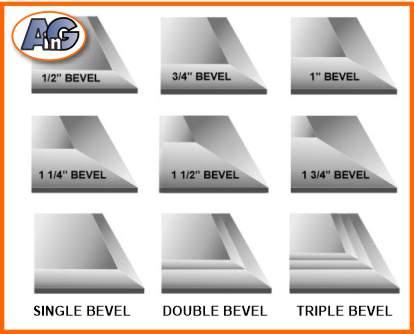
Extremely fancy double and triple-beveled edges are available for the extravagant customer but by far the most popular, for both glass and mirrors, is the standard, 1″ wide, single beveled edge.
History of glass beveling
Beveling became popular in the “Gilded Age” (1870 – 1900) when industrialization created the machinery capable of cutting and polishing glass economically and the fashion for Victorian opulence in decorative arts reached a peak.
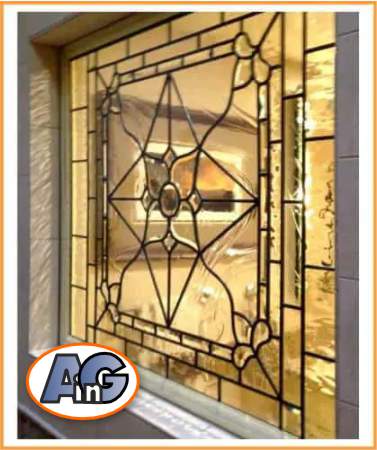
The beveled edges act as prisms in the sunlight, creating interesting diffractions and reflections that both highlight the glass artistry and provide a spectrum of colors.
In Victorian times, bevels were used not only in art glass windows but also as decorative edges to add elegance to household glass tables. For many years the standard edge on a large glass dining table was a 1″ wide, bevel.
A custom beveled edge costs more than simple polishing – so is it worthwhile? Should your glass tabletop be beveled? Find out in this post from the tabletop experts at Artistry in Glass and jump to this section for complete answers.
What kind of edges can I choose for my glass tabletop?
Glass starts off “clean-cut” with a razor-sharp edge. Note in the drawing below that the glass cutter creates microchips as it scores the glass in preparation for cutting (breaking). These microchips weaken the glass making it likely to crack.
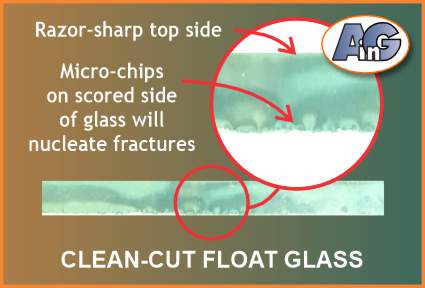
This weakness can be removed by sanding the sharp top and bottom edges of the glass to form a “seamed” edge. Note (image below) that seaming makes the glass safe to handle – it will definitely not cut you – but the appearance is irregular and unfinished.
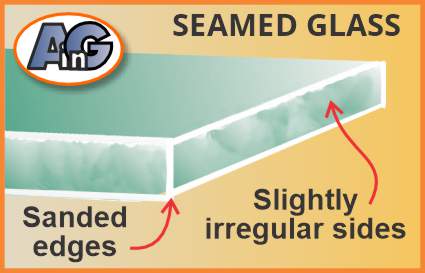
This seamed edge is OK when hidden behind a frame or molding but for furniture, it is necessary to finish the edges – a process called “edgework” in the glass business.
The commonest types of edgework include, flat polished, beveled, ogee, and grozed – see image below.
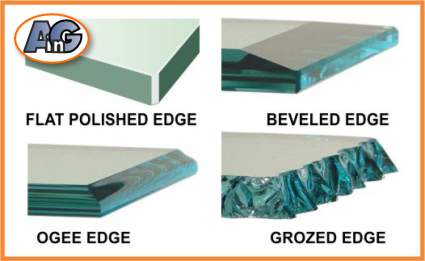
Should I choose a beveled edge for my tabletop?
There are four factors to consider when deciding whether to order a beveled glass tabletop:
- Price – beveled glass is more expensive
- Style – beveled glass is more traditional
- Use – beveled glass is slightly more comfortable
- Safety – beveled glass is slightly less safe
Price – beveled glass is more expensive
A crucial factor in pricing is that custom-sized beveled tops are expensive, but standard sizes are affordable. So consult your local glass company for pricing and remember that if you choose a standard size you can often save money.
“Standard” sizes vary but common dimensions for dining room tables are 42″ * 60″. 42″ * 72″, 44″ * 84″ and 48″ * 96″.
Smaller sizes are even more affordable because they often come with free shipping.
Style – beveled glass is more traditional
Style is a matter of personal taste. A beveled glass tabletop can add a touch of elegance to any room especially if your decor is traditional. With the correct lighting, a beveled edge can refract light and add excitement to your tabletop.
However, for the modern home with contemporary or mid-century furniture, we feel that a flat-polished edge is the better choice.
Use – beveled glass is slightly more comfortable
This factor is of minor importance because a flat-polished edge is not really uncomfortable for the average user. However, if you slouch against the side of the table, the beveled edge is slightly more comfortable on the forearms or elbows.

Safety – beveled glass is slightly less safe
Once again – this is a minor factor, but the beveled edge, especially if it is over-sized, like 1 1/2″ wide, could result in spilled cocktails if you place your glass close to the edge:
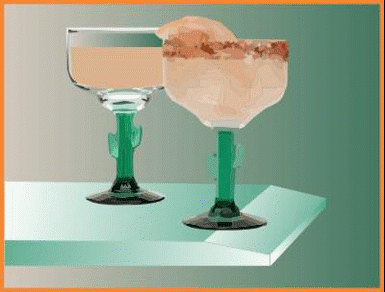
Conclusion
Consider the factors explained above – price, style, comfort, and safety and then consult your local glass company for availability and pricing. Unless you want to match existing furniture, we feel that beveling is unnecessary.
For large tabletops, remember to inquire about delivery and installation.
Imported beveled glass tabletops
If you can make do with a standard size, very good prices are currently available on Amazon. Note that good deals only apply for sizes less than about 40″ in diameter because larger tables incur large box shipping surcharges.
24″ X 48″ Tempered rectangular glass tabletop 1/2″ thick with a 1″ wide beveled edge. This imported top is substantially cheaper than a custom-made US table.
Beveled circles
38″ Diameter tempered glass tabletop 1/2″ thick with a 1″ wide beveled edge. This imported top is substantially cheaper than a custom-made US table – and it comes with free shipping.
Fun facts about beveled glass
Does the beveled side of a glass tabletop go up?
The answer seems obvious to the glass professional but young homeowners may not be sure. For the best visual effect, the beveled edge should always be facing up.
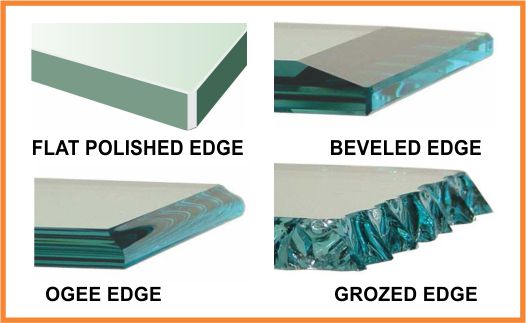
Does beveling mean smoothing?
Many customers believe that “beveling” is synonymous with “smoothing”. They often ask Artistry in Glass – “can you just bevel the edge a little?” – meaning “smooth the edge”.
It is important to understand that, in the glass business, beveling is not the same as smoothing. It means to grind and polish a (generally 1″ wide) facet around the edge of a sheet of glass or mirror.
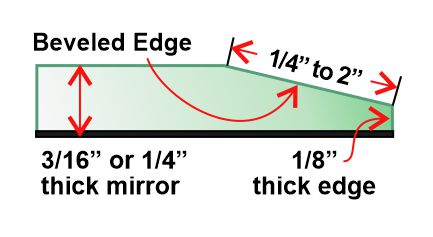
Can my local glass company bevel my glass for me?
Nearly all local glass companies get their beveled glass from factories where wholesalers have large and cost-efficient beveling machines. So, very few small companies can do custom beveling these days.

Some local glass companies or stained glass shops can make small custom bevels for special projects but these skilled artisans are increasingly hard to find.
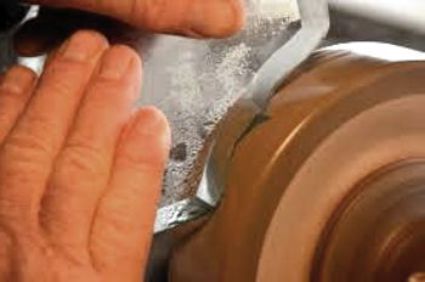
Can tempered glass be beveled?
Beveled glass can be tempered but tempered glass cannot be beveled.
This may seem like a play on words but It is important to understand that once glass has been tempered it can not be beveled, So you must specify tempered beveled glass when you make the order – your glass company will get the glass beveled, and then sent to the tempering plant.
Tempering is a very good idea for beveled coffee table tops – like the one shown below:
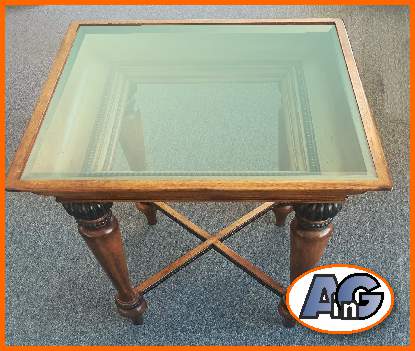
1/4″ thick beveled glass, when supported around the rim as shown about, should be tempered for safety.
Glass tabletops & shelves – info from Artistry in Glass
- Benefits of glass shelving – info from experts!
- How much do glass tabletops cost?
- Do glass shelves need to be tempered?
- What is the best thickness for glass shelves?
- Best edge type for glass shelves, polished or beveled?
- How much weight can a wall shelf carry?
- What color glass should my shelves be?
- Glass tabletops – 10 amazing benefits explained
- How to order a glass tabletop
- Best thickness for glass tabletops – expert advice
- Should glass tabletops be tempered?
- Should glass tabletops be beveled?
- How to paint a glass tabletop
- All about tempering glass tabletops!
- How to tell if your glass is tempered
- Can tempered glass be cut?
- How to protect your wood table with glass
- How to fix a scratched glass tabletop
- How to fix a chipped glass tabletop
- How to replace broken patio table glass
- How to measure for a glass tabletop
- Video – how to measure your tabletop
- Plexiglass vs glass – pros and cons
- Beveled glass table base – a case study
- Choosing between tempered & laminated glass
- Glossary of terms used in the glass business
Glass safety – learn from the experts!
- Choosing between tempered & laminated glass
- Broken glass injuries and how to avoid them
- Is wired glass safe?
- What is safety glass?
- What is tempered glass?
- What is Gorilla Glass?
- Plexiglass vs glass
- Should glass shelves be tempered?
- Should glass tabletops be tempered?
- Is lead crystal dangerous?
- Is leaded (stained) glass dangerous?
- How to repair cracked stained glass




